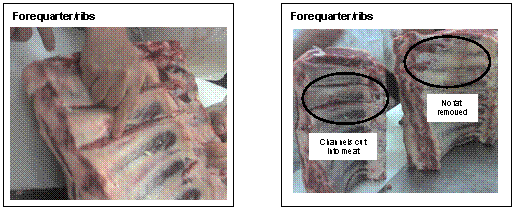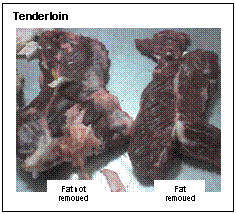Identifying Meat That Was Not Properly Menukar
Rabbi Dovid Cohen
Administrative Rabbinical Coordinator of the cRc
December 2007
On December 18, 2007 the OU presented a seminar at Romanian Kosher Sausage in Chicago on nikkur for Rabbonim, Mashgichim and others involved in kashrus who had little or no hands-on knowledge of nikkur.1 The goal of the 2 hour seminar was to teach the participants enough about nikkur to be able to spot gross errors in which nikkur wasn’t done to certain pieces of meat. The following is a summary of the most practical points.
Before a piece of meat is salted, certain fats, blood vessels and other items must be removed in a process known as nikkur/traiboring. A professional menaker can easily tell whether a piece of meat was properly menukar, but just about anyone can easily learn to recognize some telltale signs of nikkur and notice when a piece of meat is sorely lacking those signs. The coming paragraphs are intended as an introduction which the Mashgiach can build on through his own “on the job” experience. It goes without saying that if, as time goes on, a Mashgiach notices a piece of meat that does not appear to have had proper nikkur, he should bring it to the attention of an expert menaker for evaluation.
Forequarter/Ribs
Most of an animal’s chailev (forbidden fat) is in the part of the animal behind the diaphragm. To avoid the chailev, it is customary to cut the animal between the 12th and 13th ribs and sell the entire hindquarters as non-kosher.
- The cut should be clean, and none of the fat from the hindquarter should remain attached to the forequarter.

- Channels of fat and blood vessels must be removed from one end of the meat to the other between the 10th and 11th ribs, 11th and 12th ribs, and 12th rib and the “end”. After seeing a few examples of ribs that were properly menukar, it is easy to tell if nikkur was done. [In this case, as with all of the following examples, only an expert can tell if the nikkur was done perfectly, but anyone with a bit of training can tell if the nikkur was done reasonably well].
- Unfortunately, there have been cases where the person was menaker the wrong end of the meat (between the 5-8th ribs instead of the 10-13th ribs). To catch such a mistake, one must be able to recognize the different sides of that cut of meat. The large circular piece of meat alongside the 12th rib (i.e. the rib-eye steak) has much less fat running through it than the similar meat on the side of the 5th rib, and someone who has compared a few samples should be able to make this distinction.
Liver
- All fat should be removed from the surface of the liver (but fat within the flesh may remain).
- One side of the liver is naturally free of fat; by comparing the two sides one can tell whether nikkur has been done to the fattier side.
Skirt
- The skin/membrane covering the skirt (and the fat on top of it) should be removed. [Details of exactly which fat must be removed underneath the membrane are beyond the scope of this document].
Tenderloin (hanging tender)

The tenderloin is comprised of two halves, which are joined together for most of their length by a layer of fat.
- The skin/membrane covering the tenderloin should be removed.
- All fat must be removed from the surfaces on both sides of the tenderloin, but the fat holding the two halves together may remain.
- At the bottom of the tenderloin, the two halves split apart completely to take on the shape of the letter “V”, and all fat must be removed from the space between the two halves.
Bloodshot Meat
Meat which appears to be bloodshot or has signs of congealed blood, should be brought to the attention of the Rav HaMachshir.
1 The OU was represented by R’ Avrohom Juravel (OU Ingredient Department), R’ Seth Mandel (OU Rabbinic Coordinator, Meat Industry), R’ Fishel Zimmerman (OU Mashgiach and menaker at Romanian), and the coordinator of the seminar, R’ Avrohom Stone (OU Senior Mashgiach).